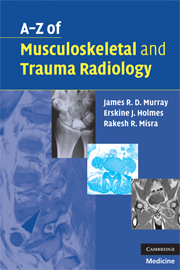Book contents
- Frontmatter
- Contents
- Acknowledgements
- Preface
- List of abbreviations
- Section I Musculoskeletal radiology
- Section II Trauma radiology
- ATLS – Advanced Trauma Life Support
- Acetabular fractures
- Aortic rupture
- Cervical spine injury
- Flail chest
- Haemothorax
- Open fractures
- Pelvic fracture
- Peri-physeal injury
- Pneumothorax
- Rib/sternal fracture
- Skull fracture
- Thoraco-lumbar spine fractures
- Acromioclavicular joint injury
- Carpal dislocation and instability
- Clavicular fractures
- Elbow injuries and distal humeral fractures
- Hand injuries – general principles
- Hand injuries – specific examples
- Thumb metacarpal fractures
- Humerus fracture – proximal fractures
- Humerus fracture – shaft fractures
- Humerus fracture – supracondylar fractures – paediatric
- Radius fracture – head of radius fractures
- Radius fracture – shaft fractures
- Galeazzi fracture dislocation
- Radius fracture – distal radial fractures
- Related wrist fractures
- Scaphoid fracture
- Scapular fracture
- Shoulder dislocation
- Ulna fracture – proximal and olecranon fractures
- Ulna fracture – shaft fractures
- Monteggia fracture dislocation
- Accessory ossicles of the foot
- Ankle fractures
- Bone bruising
- Calcaneal (Os calcis) fractures
- Femoral neck fracture
- Femoral shaft fracture
- Femoral supracondylar fracture
- Hip dislocation – traumatic
- Knee soft-tissue injury
- Metatarsal fractures – commonly fifth MT base
- Patella fracture
- Tibial-plateau fracture
- Tibial-shaft fractures
- Tibial-plafond (Pilon) fractures
- Talus fractures/dislocations
Pelvic fracture
from Section II - Trauma radiology
Published online by Cambridge University Press: 22 August 2009
- Frontmatter
- Contents
- Acknowledgements
- Preface
- List of abbreviations
- Section I Musculoskeletal radiology
- Section II Trauma radiology
- ATLS – Advanced Trauma Life Support
- Acetabular fractures
- Aortic rupture
- Cervical spine injury
- Flail chest
- Haemothorax
- Open fractures
- Pelvic fracture
- Peri-physeal injury
- Pneumothorax
- Rib/sternal fracture
- Skull fracture
- Thoraco-lumbar spine fractures
- Acromioclavicular joint injury
- Carpal dislocation and instability
- Clavicular fractures
- Elbow injuries and distal humeral fractures
- Hand injuries – general principles
- Hand injuries – specific examples
- Thumb metacarpal fractures
- Humerus fracture – proximal fractures
- Humerus fracture – shaft fractures
- Humerus fracture – supracondylar fractures – paediatric
- Radius fracture – head of radius fractures
- Radius fracture – shaft fractures
- Galeazzi fracture dislocation
- Radius fracture – distal radial fractures
- Related wrist fractures
- Scaphoid fracture
- Scapular fracture
- Shoulder dislocation
- Ulna fracture – proximal and olecranon fractures
- Ulna fracture – shaft fractures
- Monteggia fracture dislocation
- Accessory ossicles of the foot
- Ankle fractures
- Bone bruising
- Calcaneal (Os calcis) fractures
- Femoral neck fracture
- Femoral shaft fracture
- Femoral supracondylar fracture
- Hip dislocation – traumatic
- Knee soft-tissue injury
- Metatarsal fractures – commonly fifth MT base
- Patella fracture
- Tibial-plateau fracture
- Tibial-shaft fractures
- Tibial-plafond (Pilon) fractures
- Talus fractures/dislocations
Summary
Characteristics
Usually secondary to massive force such as a road-traffic accident or fall from a height.
May be associated with vascular, soft-tissue and visceral injuries.
If the ring is broken in two places the fracture is likely to be unstable – don't forget the sacroiliac joint as a site of disruption.
Isolated ring fractures tend to be stable, e.g. an isolated pubic ramus fracture.
Tile classification –
A – stable – Not involving the pelvic ring (e.g. avulsion fractures) or minimally displaced involving the pelvic ring (pubic rami fractures).
B – vertically stable, rotationally unstable – AP compression (open book) and lateral compression (e.g. rami fracture with associated crushing injury of the sacroiliac joint).
C – unstable – Disruption of the pelvic ring at two or more levels (e.g. bilateral rami fractures or pubic symphysis disruption).
Clinical features
Suspect from history.
Haemorrhagic shock is commonly seen due to vascular nature of the pelvic bones, closely related large vessels and large associated muscle groups.
Shock is often compounded by haemorrhage from associated injuries in the thorax, abdomen and extremities.
Beware urogenital and rectal disruption – look for perineal bruising, high or impalpable prostate and blood at the urethral meatus.
Gentle pelvic testing may reveal instability. Avoid repeated examination.
In the elderly, they may present similarly to suspected femoral neck fracture.
Radiological features
Obtain pelvic views in multiple trauma patients and with unexplained shock following trauma.
Assess the pelvic ‘rings’ for steps or asymmetry.
Compare like for like, bearing in mind rotational differences.
Always closely examine the pubic rami and acetabulae in the elderly patient with a suspected neck-of-femur fracture.
CT is a very useful modality to assess severity, reveal associated injuries and assist in the planning of surgery.
- Type
- Chapter
- Information
- A-Z of Musculoskeletal and Trauma Radiology , pp. 202 - 204Publisher: Cambridge University PressPrint publication year: 2008



